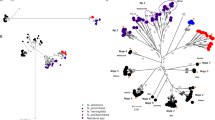Abstract
In order to assess the relationships among strains of the genera Actinobacillus and Haemophilus, DNAs from 50 strains of these genera were isolated and purified. The guanine plus cytosine (G+C) content of DNAs from strains of Haemophilus segnis and Haemophilus para-influenzae were determined by thermal denaturation. DNA-DNA homologies were measured using labelled probes from one strain representing Haemophilus segnis (strain ATCC 10977), and two strains representing Haemophilus parainfluenzae (strains ATCC 9796 and ATCC 7901). Strains isolated as H. segnis had a G+C content of 39.0 to 42.9% and were 49–92% homologous with the ATCC 10977 DNA probe. All of the strains freshly isolated as H. parainfluenzae were 70–81% homologous with the ATCC 9796 DNA probe and had a G+C content of 34.9 to 38.3%. Strain ATCC 7901 was 11% homologous with the ATCC 9796 DNA probe, had a G+C content of 42.4%, and was 65–78% homologous to DNA from strains identified as Haemophilus aphrophilus and Haemophilus paraphrophilus. From these results we conclude that strain ATCC 7901 is a mislabelled strain of H. paraphrophilus. The results of multiple DNA-DNA hybridizations indicated that separate species designations were appropriate for H. segnis, H. parainfluenzae, Actinobacillus actinomycetemcomitans (“Haemophilus actinomycetemcomitans”), and H. aphrophilus. H. aphrophilus and H. paraphrophilus were closely related organisms and did not fulfill the generally accepted criteria for designation as separate species.
Similar content being viewed by others
References
Coykendall AL, Setterfield J, Slots J (1983) Deoxyribonucleic acid relatedness among Actinobacillus actinomycetemcomitans, Haemophilus aphrophilus, and other Actinobacillus species. Int J Syst Bacteriol 33:422–424
Crosa J, Brenner D, Falkow S (1973) Use of a single strand specific nuclease for analysis of bacterial and plasmid deoxyribonucleic acid homo- and heteroduplexes. J Bacteriol 115:903–911
Johnson JL (1973) Use of nucleic acid homologies in the taxonomy of anaerobic bacteria. Int J Syst Bacteriol 23:308–315
Kilian M (1976) A taxonomic study of the genus Haemophilus, with the proposal of a new species. J Gen Microbiol 93:9–61
Kilian M, Biberstein EL (1984) Genus II. Haemophilus Winslow, Broadhurst, Buchanan, Krumweide, Rogers, and Smith 1917, 561. In: Krieg NR, Holt JG (eds) Bergey's manual of systematic bacteriology, vol 1. Williams and Wilkins, Baltimore, pp 558–569
Kilian M, Schiott CR (1975) Haemophili and related bacteria in the human oral cavity. Archs Oral Biol 20:791–796
Marmur J (1961) A procedure for the isolation of deoxyribonucleic acid from microorganisms. J Mol Biol 3:208–218
Marmur J, Doty P (1962) Determination of the base composition of deoxyribonucleic acids. J Mol Biol 3:109–118
Marmur J, Doty P (1961) Thermal renaturation of deoxyribonucleic acids. J Mol Biol 3:585–594
Pohl S (1981) DNA relatedness among members of Haemophilus, Pasteurella, and Actinobacillus. In: Kilian M, Frederiksen W, Biberstein EL (eds) Haemophilus, Pasteurella, and Actinobacillus. Academic Press, New York, pp 245–253
Pohl S (1983) Transfer of Haemophilus pleuropneumoniae and the Pasteurella haemolyticus-like organism causing porcine necrotic pleuropeumonia to the genus Actinobacillus (Actinobacillus pleuropneumoniae comb. nov.) on the basis of phenotypic and deoxyribonucleic acid relatedness. Int J Syst Bacteriol 33: 510–514
Potts TV, Berry EM (1983) Deoxyribonucleic acid-deoxyribonucleic acid hybridization analysis of Actinobacillus actinomycetemcomitans and Haemophilus aphrophilus. Int J Syst Bacteriol 33:765–771
Potts TV, Holdeman LV, Slots J (1983) Relationships among the oral fusobacteria assessed by DNA-DNA hybridization. J Dent Res 62:702–705
Potts TV, Zambon JJ, Genco RJ (1985) Reassignment of Actinobacillus actinomycetemcomitans to the genus Haemophilus as Haemophilus actinomycetemcomitans comb. nov. Int J Syst Bacteriol 35:337–341
Schleifer KH, Stackebrandt E (1983) Molecular systematics of procaryotes. Ann Rev Microbiol 37:143–187
Sneath PHA, Johnson R (1973) Numerical taxonomy of Haemophilus and related bacteria. Int J Syst Bacteriol 23:405–418
Tarrand JJ, Groschel DHM (1982) Rapid modified oxidase test for oxidase-variable bacterial isolates. J Clin Microbiol 16:772–774
Author information
Authors and Affiliations
Rights and permissions
About this article
Cite this article
Potts, T.V., Mitra, T., O'Keefe, T. et al. Relationships among isolates of oral haemophili as determined by DNA-DNA hybridization. Arch. Microbiol. 145, 136–141 (1986). https://doi.org/10.1007/BF00446770
Received:
Accepted:
Issue Date:
DOI: https://doi.org/10.1007/BF00446770




